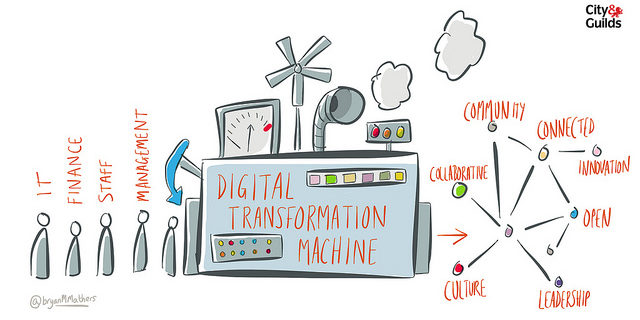
NEWS
Digital transformation in the audiovisual sector?
Quite some time ago that I am spinning to write a post about the Digital Transformation in our industry, but the issue I have resisted, because it is one of those concepts as broad and that everyone talks about, that it is difficult to get them down to the earth without the risk of getting as a seller of smoke. But we are here to take risks, so there goes.
– But Carles, this digital transformation what we have overcome, for years, we are digitized and work with files, MAMs, editions, not linear... This Digital Transformation is for the sectors in technology, we're back!!
This is the response that more than one we can have as we speak deTransformación Digital. We are ALREADY digital!! And our effort has cost us!! To go with the roll digital in the retail sector that they who are behind technologically!! Our industry is one of the most evolved!!.
It is true. We are digital (well, most) and that has helped to improve the efficiency of the processes and to reduce costs. No one argues that only one person can be editing with the only tape copy of the program. We have automated processes, but they are the same processes that we already had from the time analog and which were related to the media. But what about the other departments? The people's programming, scheduling, promotions, what have adopted tools to improve your processes, or continue to do so as always? Because, in most cases still with your Excel of all life.
Digital transformation does not mean only digitized, it does not mean to buy a MAM or have a transcoder, and of course does it mean to issue the straight-line with a video server, or even have the programs uploaded to the web!.
Digital Transformation goes far beyond that. It is not a change of technology, but without the technology could not have transformation. It is a process of change, above all in the business models, the relationship with the consumers, in the management of social networks, and of course in the processes of the organization to adapt to the new paradigm.
We can make the parallel with the music industry. The step of the vinyl to the CD was a scan but nothing more (and nothing less!). But it was just a change in technology. The true disruption of the business model is in the change of the consumer. Not to go to the store to buy a CD but subscribe to Spotify for listening to music. And share your playlist preferred with his friends to all have it ready before the feast of the sabbath.
The Internet is the key factor that generates these processes of transformation. The consumer of multimedia content has entered the digital culture. Twitter, Whatsapp, Spotify, Youtube, Facebook, are platforms that have changed the habits of our viewers. They have gone from being a passive spectator to interact in a digital world and become a consumer-builder-recommender-collaborative content.
One of the challenges of the Digital Transformation is the strategic vision. To meet the challenge of digital is that you analyze the market, the new consumption habits, and to anticipate the actions, to see what value you can bring and make the necessary changes in the company and in the process to undertake these changes more quickly than the competition. Agility and low costs, model startup. There are also redefining the concept Broadcast from the innovation in the business model and align the technology with him.
If to post a video on our website requires manual actions of a user: download MAM, transcoding, delivery to the CDN, search the metadata, introduction to the CMS, promotion on Twitter and Facebook... we are at a clear disadvantage compared to the competition, and the costs are going to be inasumibles in terms of scale the model. Many of the televisions are trying to enter in the new models but with manual processes and that is not sustainable. It's like trying to manage a continuity without automation, with two VTRS and a mixer video... Nobody would dream of something like this today.. so what, then, because we manage our website, our VOD with methods as cave?
It seems that we all have that clear. If we see the study of Devoncroft of the last 5 years, we see that the first trend of the market between 2011 and 2015 was the content delivery platform (Broadcast, web, mobile). And it should be easy once you're digitized, but how Many television stations or operators are making the publication of content as described in the previous paragraph? I bet that more than one and two.
Photo: CC BY-ND 2.0 Bryan Mathers
LATEST ENTRIES
- Podcast de ebantic «Líders Digitals»
- The "Hidden" Cost Of To Not Have A DAM
- Ebantic in the MAC 2025: technology, ideas, and eager to transform the local audiovisual
- We're joining forces with Amplify to bring AI to the audiovisual world!
- MuseumOTT + MuseumDAM: The ultimate solution for digital museum management.
- What a MWC 2025 we had!
- Introducing MuseumDAM at MWC 2025!
- We close ISE 2025 with great satisfaction!
- We're ready for ISE2025!
- Ebantic presents its four new business units
FILE
CATEGORIES
Drive Your Innovation with Our Services
At ebantic we help our customers to take strategic decisions in real-time.
